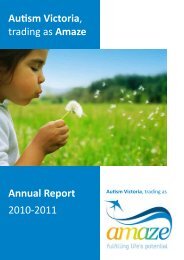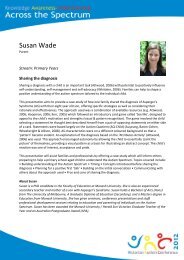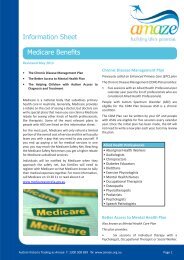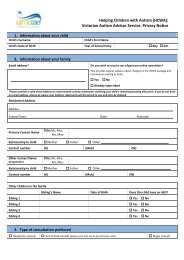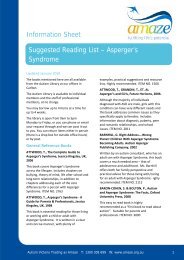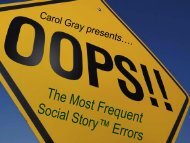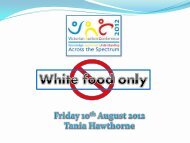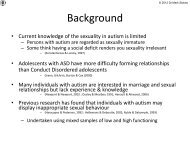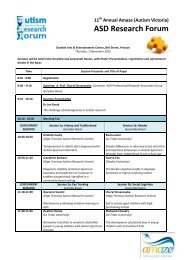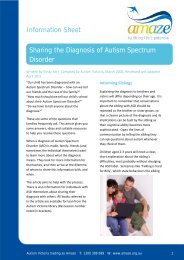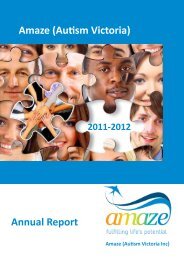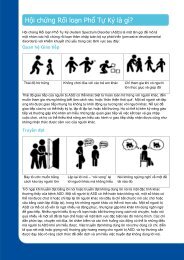Autism - Amaze
Autism - Amaze
Autism - Amaze
Create successful ePaper yourself
Turn your PDF publications into a flip-book with our unique Google optimized e-Paper software.
autism victoria, trading asPhone support forindividuals, parents andfamiliesNational Registered TrainingOrganisation (RTO) providingCertified Training Courses andtailored professional developmentInformation sessions, workshops,seminars and professionaldevelopmentPhone support for practitioners,health professionals, education andemployment servicesNational <strong>Autism</strong> AccreditationProgram providing therapistsand organisations with a qualityframework improving outcomes forpeople with an ASDAdministration of the FaHCSIA'Helping Children with <strong>Autism</strong>'Funding Program (HCWA) in VictoriaMembership: providingbenefits for individuals andprofessionalsMember 2011:12A range of information services:<strong>Autism</strong> Library, online information,fact sheets, quarterly SpectrumMagazine, eSpectrum enewsletter2012Victorian <strong>Autism</strong> ConferenceBiennial Victorian <strong>Autism</strong>Conference in Melbourne andaround the stateSpecialist counselling service to assistindividuals, parents and familiesProducts to assist individualswith ASDs and to help promoteawarenessIn-house directory of servicescontaining details of autism-awareservices for those affected by ASDs<strong>Autism</strong> Victoria is a registered charity and is happy to receive donations. The organisation is funded by theAustralian Government Department of Families, Housing, Community Services and Indigenous Affairs (FaHCSIA),and by the Victorian Government Department of Human Services (DHS) and Department of Education and EarlyChildhood Development (DEECD) to run some of the programs mentioned above.4<strong>Autism</strong> Victoria Inc trading as <strong>Amaze</strong>ABN 15 600 724 949Registered Vic Fundraiser 9923T: (03) 9657 1600F: (03) 9639 4955E: info@amaze.org.auW: www.amaze.org.au
Welcome from the ConvenorIt is with much pleasure that I welcome all registrants to the 11th Annual <strong>Amaze</strong> (<strong>Autism</strong> Victoria) ASDResearch Forum! Research focused on ASDs is clearly on the rise in Victoria. The number of submissionsfor talks and posters has increased steadily over the last years, culminating this year in the need for parallelsessions to accommodate all the excellent research presentations! Thus we have a stimulating and fullprogram of oral and poster presentations today which span the entire developmental period and an arrayof research disciplines, all focused on ASDs.I would like to extend a warm welcome to our Keynote Speaker, Dr Jon Brock from Macquarie University,who will speak to us on ‘The Challenge of Heterogeneity in <strong>Autism</strong> Research’. This is an important topicthat has been paid scant regard despite us all, as autism researchers, facing this pervasive issue in all of ourwork.I would like to acknowledge the work of Lia Castorina and her team at <strong>Amaze</strong> who work behind the sceneseach year to ensure that this forum is a successful one. Thank you to them all, and also to Dr DavidHamilton from the ASD Professional Research Associates Group who assisted with reviewing the abstracts.And thanks to all other members of this group, each of them academics from Victorian Universities, whosupport this forum.Thank you for attending and participating today. I hope you enjoy the forum, and invite you to return nextyear.Cheryl Dissanayake, Ph.D, MAPSConvenor, ASD Professional Research Associates GroupAssociate Professor and Reader, School of Psychological ScienceDirector, Olga Tennison <strong>Autism</strong> Research CentreLa Trobe University, Bundoora, Victoria 3083<strong>Autism</strong>Spectrum DisorderResearchForum5
Contents2012 ASD Research Forum Program........................................................................................................................................... 8Oral Presentation AbstractsSession 1a Infancy and Toddlerhood - Chair: David Hamilton.................................................................................................. 10Kristelle Hudry, Olga Tennison <strong>Autism</strong> Research Centre........................................................................................................... 10Josephine Barbaro, Olga Tennison <strong>Autism</strong> Research Centre.................................................................................................... 11Session 1b Gender - Chair: Mark Stokes ................................................................................................................................... 11Rucha Joshi, La Trobe University............................................................................................................................................... 11Ivanna Cox, Deakin University.................................................................................................................................................. 12Session 2a Eye Tracking - Chair: Jane McGillivray..................................................................................................................... 13Giacomo Vivanti, Olga Tennison <strong>Autism</strong> Research Centre........................................................................................................ 13Heather Nuske, La Trobe University......................................................................................................................................... 13Kavi Jayasinghe, Olga Tennison <strong>Autism</strong> Research Centre......................................................................................................... 14David Trembath, La Trobe University........................................................................................................................................ 15Session 2b Social Cognition - Chair: Jordy Kaufman................................................................................................................. 15Cheryl Dissanayake, Olga Tennision <strong>Autism</strong> Research Centre.................................................................................................. 15Mahwish Chaudry, La Trobe University..................................................................................................................................... 16Susan Douglas, University of Melbourne................................................................................................................................. 16Emma Pezzotto, Olga Tennison <strong>Autism</strong> Research Centre......................................................................................................... 17Session 3 Biology - Chair: Amanda Richdale ............................................................................................................................ 17Cherie Green, Olga Tennison <strong>Autism</strong> Research Centre............................................................................................................. 17Naomi Bishop, La Trobe University........................................................................................................................................... 18Elisa Hill Yardin, University of Melbourne................................................................................................................................ 18Session 4 Intervention - Chair: Kristelle Hudry.......................................................................................................................... 20Monica Carr, Monash University.............................................................................................................................................. 20Grace Thompson, University of Melbourne............................................................................................................................. 20Session 5 Adolescents and Parents - Chair: Cheryl Dissanayake.............................................................................................. 21Rebecca McStay, Olga Tennison <strong>Autism</strong> Research Centre........................................................................................................ 21Ru Ying-Cai, Olga Tennison <strong>Autism</strong> Research Centre................................................................................................................ 21Poster Presentation Abstracts1. Melissa Kirkovski, Monash University................................................................................................................................... 222. Melinda Randall, University of Melbourne, Royal Children’s Hospital................................................................................. 233. Beth Johnson, Monash University........................................................................................................................................ 234. Melina Ellis, Elisa Hill Yardin The University of Melbourne.................................................................................................. 235. Tania Hawthorne, Over the Spectrum.................................................................................................................................. 246. Ha Song Vu, The University of Queensland.......................................................................................................................... 247. Thi Duong, Deakin University, Curtin University................................................................................................................... 258. PuiTzan Chan, Monash University......................................................................................................................................... 259. Nusrat Yasmeen Ahmed, Amanda Richdale......................................................................................................................... 266
11th Annual <strong>Amaze</strong> (<strong>Autism</strong> Victoria)ASD Research ForumPoster PresentationsFoyer Area*The authors will be present at the times indicated to discuss their work and findingsPoster Presenter Time* Insitution/s Title of Poster1. Melissa Kirkovski 12:30 - 1:00 Monash University A Review of the Role of Female Gender in<strong>Autism</strong> Spectrum Disorders2. Melinda Randall 12:30 - 1:00 University ofMelbourne, RoyalChildren’s Hospital,and othersA systematic review on the diagnostictest accuracy of the diagnostic tools fordiagnosing <strong>Autism</strong> Spectrum Disorders3. Beth Johnson 12:30 - 1:00 Monash University A closer look at visually guided eyemovements and adaptation in autism andAsperger’s disorder4. Melina Ellis & Elisa Hill-Yardin12:30 - 1:00 The University ofMelbourneGastrointestinal dysfunction in theNeuroligin-3 mouse model of autism5. Tania Hawthorne 1:00 - 1:30 Over the Spectrum The improvement of quality of life for a childwith ASD and his family through an increasein the variety and quantity of foods eaten ona regular basis6. Ha Song Vu 1:00 - 1:30 The University ofQueensland7. Thi Duong 1:00 - 1:30 Deakin University andCurtin UniversityUsing photovoice in research with childrenwith ASD in Hanoi, VietnamToby (Therapy outcomes by you) - anaccelerated learning tool for children with<strong>Autism</strong>8. PuiTzan Chan 1:00 - 1:30 Monash University Teaching Children with <strong>Autism</strong> SpectrumDisorder how to write their name usingVideo Modelling and Chaining9. Nusrat Yasmeen Ahmed 1:00 - 1:30 Intervention focussing on the interactionstyles of parents and therapists of childrenwith autism and limited speech: Case studiesfrom Bangladesh7
11th Annual <strong>Amaze</strong> (<strong>Autism</strong> Victoria)ASD Research ForumDarebin Arts & Entertainment Centre, Bell Street, PrestonThursday, 1 November 2012Sessions will be held in the Grevillea and Jacaranda Rooms, with Poster Presentations, registration and refreshment breaks in the foyer.Time8:45 - 9:00 RegistrationSession Presenter and Title of Paper9:00 - 9:10 Opening: A. Prof. Cheryl Dissanayake, Convenor, ASD Professional Research Associates GroupGrevillea Room9:10 - 10:10 Keynote PresentationChair: Cheryl DissanayakeDr Jon BrockThe challenge of heterogeneity in autism research10:10 - 10:30 Morning TeaCONCURRENTSESSIONSSession 1a: Infancy and ToddlerhoodGrevillea RoomChair: David Hamilton10:30 - 10:50 Kristelle Hudry(Olga Tennison <strong>Autism</strong> Research Centre)Temperament in infants later diagnosed with<strong>Autism</strong> Spectrum Disorders10:50 - 11:10 Josephine Barbaro(Olga Tennison <strong>Autism</strong> Research Centre)CONCURRENTSESSIONSDiagnostic stability of <strong>Autism</strong> SpectrumDisorders and predictors of crossover in toddlersprospectively identified in a community-basedsettingSession 2a: Eye TrackingGrevillea RoomChair: Jane McGillivray11:10 - 11:30 Giacomo Vivanti(Olga Tennison <strong>Autism</strong> Research Centre)Mechanisms underlying imitative learning inASD11:30 - 11:50 Heather Nuske(La Trobe University)Normative reactivity to emotions of familiarpeople in young children with ASD11:50 - 12:10 Kavi Jayasinghe(Olga Tennison <strong>Autism</strong> Research Centre)Emotion salience in young children with <strong>Autism</strong>Spectrum DisorderSession 1b: GenderJacaranda RoomChair: Mark StokesRucha Joshi(La Trobe University)Gender differences in observed social attentionand repetitive behaviours in <strong>Autism</strong> SpectrumDisorder from toddlerhood to pre-school ageIvanna Cox(Deakin University)The female cognitive profile in AspergerSyndrome or high functioning autismSession 2b: Social CognitionJacaranda RoomChair: Jordy KaufmanCheryl Dissanayake(Olga Tennison <strong>Autism</strong> Research Centre)Self in school-aged children withhigh-functioning autismMahwish Chaudry(La Trobe University)The development of pretend play in youngchildren with and without ASDSusan Douglas(University of Melbourne)The co-construction of pretence in social pretend play8
11th Annual <strong>Amaze</strong> (<strong>Autism</strong> Victoria)ASD Research ForumDarebin Arts & Entertainment Centre, Bell Street, PrestonThursday, 1 November 2012Sessions will be held in the Grevillea and Jacaranda Rooms, with Poster Presentations, registration and refreshment breaks in the foyer.TimeCONCURRENTSESSIONS12:10 - 12:30 David Trembath(La Trobe University)Session 2a: Eye TrackingGrevillea RoomChair: Jane McGillivraySession Presenter and Title of PaperSession 2b: Social CognitionJacaranda RoomChair: Jordy KaufmanEmma Pezzotto(Olga Tennison <strong>Autism</strong> Research Centre)Are children with autism really visual learners? Acommunication and eye tracking studyThe relationship between contagious yawning, empathy,and social skills in typically developing children12:30 - 1:30 Lunch & Poster PresentationsSession 3: BiologyGrevillea RoomChair: Amanda Richdale1:30 - 1:50 Cherie Green (Olga Tennison <strong>Autism</strong> Research Centre)Growth dysregulation in boys with <strong>Autism</strong> Spectrum Disorder1:50 - 2:10 Naomi Bishop (La Trobe University)Understanding mitochondrial dysfunction in autism2:10 - 2:30 Elisa Hill-Yardin (The University of Melbourne)Modelling <strong>Autism</strong> Spectrum Disorders in miceSession 4: InterventionGrevillea RoomChair: Kristelle Hudry2:30 - 2:50 Monica Carr (Monash University)Research on the effects of Self-Management Interventions on Children with <strong>Autism</strong>; a Meta-Analysis2:50 - 3:10 Grace Thompson (The University of Melbourne)Family-centred music therapy: supporting connectedness between mothers and children with severe <strong>Autism</strong> SpectrumDisorder3:10 - 3:30 Afternoon TeaSession 5: Adolescents and ParentsGrevillea RoomChair: Cheryl Dissanayake3:30 - 3:50 Rebecca McStay (Olga Tennison <strong>Autism</strong> Research Centre)Parenting stress and <strong>Autism</strong>: The role of age, autism severity, quality of life, and problem behaviour of childrenand adolescents with high-functioning autism.3:50 - 4:10 Ru Ying-Cai (Olga Tennison <strong>Autism</strong> Research Centre)Supporting tertiary students with <strong>Autism</strong> Spectrum Disorders: Online mentoring4:10 - 4:30 Sum up and close9
Oral PresentationsKEYNOTE ADDRESS9:10am – 10:10amChair: Cheryl DissanayakeDr Jon BrockThe challenge of heterogeneity in autism research10SESSION 1a: Infancy and Toddlerhood10:30 – 11:10Chair: David HamiltonGrevillea RoomTemperament in infants later diagnosed with <strong>Autism</strong> Spectrum DisordersResearcher: Kristelle HudryOther Researchers: Sally Clifford, Mayada Elsabbagh, Tony Charman, Mark H. Johnson, and the BASISTeam*Academic Institution/s: Olga Tennsion <strong>Autism</strong> Research Centre, La Trobe University (K.Hudry)Charles Sturt University (S.Clifford), University of London (M.Elsabbagh, T.Charman, M.Johnson), McGillUniversity (M.Elsabbagh)Background:Studies of infants who go on to develop <strong>Autism</strong> Spectrum Disorders (ASD) have tended to focus on identifying specificpredictors of later diagnostic outcome; individual markers or clusters of ‘red-flags’. Recently, however, attention hasturned to consider whether broad behavioural traits might be potentially informative of early atypical development.Objectives:The current study aimed to investigate temperament – broad patterns of behaviour showing stability over time – ininfants later diagnosed with ASD, using a familial high-risk design.Method:A group of 54 high-risk infants (each with an older sibling with ASD) and a group of 50 low-risk controls were followedprospectively from early infancy beyond the third birthday. Temperament was assessed via parent-report wheninfants were around 7, 14 and 24 months of age. Comprehensive diagnostic assessment, conducted around thetoddlers’ third birthdays, indicated a sub-group of 17 high-risk infants had developed an ASD.Results:Compared to controls, high-risk infants as a group showed reduced Surgency at 7 and 14 months and reducedEffortful Control at 14 and 24 months. Those individuals later diagnosed with ASD could be distinguished early onfrom controls, presenting a temperament profile of increased Perceptual Sensitivity from the first year of life andincreased Negative Affect and reduced Cuddliness in the second year.Conclusions:Temperament may present as an important construct for understanding the early development of ASD across infancy,differentiable from the typical infant development and also from development within the limits of sub-clinicalbroader autism phenotype.
Oral PresentationsDiagnostic stability of <strong>Autism</strong> Spectrum Disorders and predictors of crossover in toddlersprospectively identified in a community-based settingResearcher: Josephine BarbaroOther Researchers: Associate Professor Cheryl DissanayakeAcademic Institution/s: Olga Tennison <strong>Autism</strong> Research Centre, La Trobe UniversityBackground:Diagnoses of <strong>Autism</strong> Spectrum Disorders (ASD) at 2-years-of-age have been established as relatively stable acrosstime in high-risk samples; however, diagnostic stability in children identified from low-risk samples is not wellestablished.Objectives:The primary objective in this longitudinal study was to investigate the diagnostic stability of ASD diagnoses from2- to 4-years in children prospectively identified through routine developmental surveillance. A secondary objectivewas to identify behaviours that were most predictive of diagnostic crossover, and compare the cognitive profiles ofASD-stable versus ASD-crossover groups.Method:Ninety-nine children received a best estimate diagnosis of an ASD or developmental/language delay at 24-months(Time 1) using the ADOS, ADI-R, Mullen Scales, and clinical judgement; 77 children returned for a follow-up diagnosticassessment at 4-years (Time 2).Results:Diagnostic stability was high, with 86% of children retaining their ASD diagnosis; stability of diagnoses within thespectrum was more variable. There were significant differences in ADOS Time 1 scores for ‘Unusual Eye Contact’,‘Frequency of Vocalizations Directed to Others’, and ‘Integration of Gaze and Other Behaviours’ between ASD-stable(53) and ASD-crossover (9) groups, with the ASD-stable group displaying greater abnormality in these behaviours.Furthermore, the ASD-stable group had significantly lower visual reception, fine motor, and receptive language skillsat Time 1, with the greatest mean difference in receptive language.Conclusions:Consistent with previous studies, ASD diagnoses at 2-years-of-age are stable, with the best predictors of diagnosticcrossover consisting of not only the use of eye contact and Vocalizations directed towards others, but the integrationof these behaviours. Higher receptive language in the ASD-crossover versus ASD-stable group is consistent with ourprevious findings that higher receptive language skills in the latter part of the second year of life may place childrenon a developmental trajectory away from the autism spectrum.SESSION 1b: Gender10:30 – 11:10Chair: Mark StokesJacaranda RoomGender differences in observed social attention and repetitive behaviours in <strong>Autism</strong>Spectrum Disorder from toddlerhood and pre-school ageResearcher: Rucha JoshiResearch Supervisor/s: A/Prof Cheryl DissanayakeOther Researchers: Dr Josephine BarbaroAcademic Institution/s: La Trobe University11
Oral PresentationsBackground:Very few studies to date have investigated gender differences in the development of young children later diagnosedwith an <strong>Autism</strong> Spectrum Disorder (ASD) and none of these have used direct behavioural observation to understandthese gender differences over a period of time.Objectives:The aim in this study was to investigate gender differences in the development of Social Attention Behaviours andRestricted Repetitive Behaviours (RRBs) from toddlerhood to pre-school age in a matched sample of young boys andgirls diagnosed with an ASD.Methods:The sample comprised of 10 Boys and 10 Girls, matched on Verbal Mental Age and Developmental Quotient,diagnosed with an ASD through the Social Attention and Communication Study (SACS, Barbaro & Dissanayake, 2010).One hour of assessment video footage of these children at 2- and 4- years were coded in detail for the occurrence ofASD specific Social Attention and RRBs.Results:No gender differences were found in early social attention behaviours as assessed by Gender X Time MANOVAs and,RRBs as assessed using non-parametric analyses. However both genders showed a significant improvement over timein their social functioning from 2- to 4-years of age.Conclusions:The results indicate a similar behavioural profile in this matched sample of boys and girls diagnosed with an ASD intheir social attention as well as RRBs from toddlerhood to pre-school age. The cohort is unique in providing directbehaviour observational data on a community based sample from two to four years of age as, to date, no suchsample has been examined in relation to gender differences. Such studies are needed to understand similarities anddifferences in the early progression of ASDs in girls and boys.The female cognitive profile in Asperger Syndrome or high functioning <strong>Autism</strong>Researcher: Ivanna CoxResearch Supervisor/s: Dr Mark Stokes & Dr Jane McGillivrayOther Researchers: Professor Tony Attwood, Dr Janine Manjiviona, & Tom PerkinsAcademic Institution/s: Deakin UniversityA gender disparity exists across <strong>Autism</strong> Spectrum Disorders (ASDs) where males outnumber females. Intelligenceappears to have a moderating effect, whereby the differences are more pronounced in the higher ranges of IQ, asreflected by Asperger syndrome or high-functioning autism (AS/HFA). Despite the limited research, differences in thecognitive profiles of males and females with an ASD are evident. Based on the previous research presented on sexdifferences in AS/HFA and in typical development, it was predicted the cognitive profiles would differ between maleand female adolescents with AS/HFA, and from typically developing (TD) peers.In the current study, the sample of 48 adolescents between 12 and 18 years were divided by diagnosis and sexmaking four groups comprised of 12 AS/HFA males, 12 AS/HFA females, 12 TD males, and 12 TD females. Participantsunderwent cognitive assessments (WISC-IV or WAIS-IV). Developmental histories were collected from parentsand the <strong>Autism</strong>-Spectrum Quotient (AQ) questionnaire completed by participants or the parents on behalf of theparticipant. Mixed model analysis of variance (ANOVA) and analysis of covariance (ANCOVA) revealed that the AS/HFA males, AS/HFA females, TD males, and TD females were comparable on cognitive performance. Yet, the AS/HFA group scored significantly lower than TD group on cognitive measures, particularly on processing speed. Thus,hypothesis one was not supported.In conclusion, males and females with AS/HFA display homogenous cognitive profiles.12
Oral PresentationsSESSION 2a: Eye Tracking11:10 – 12:30Chair: Jane McGillivrayGrevillea RoomMechanisms underlying imitative learning in ASDResearcher: Giacomo VivantiResearch Supervisor/s: Cheryl DissanayakeAcademic Institution/s: La Trobe UniversityBackground:Difficulties in learning from others by imitation are frequently documented in children with <strong>Autism</strong> SpectrumDisorders (ASD). The neurocognitive mechanisms underlying the imitative learning deficit in ASD remain unknown.Objectives:Our aim was to determine whether deficits in imitative learning in ASD reflect 1) problems with attention tothe demonstration (visual encoding hypothesis), 2) problems with mapping the others goals onto self’s motorrepresentation (self-other mapping hypothesis) or 3) a problem with planning and executing actions (executivehypothesis).Methods:Participants were 30 2- to 5- year old children with an ASD, who where compared to 19 age-matched typicallydeveloping (TD) children. A test of imitative learning was administered to all participants. To test our hypotheses wealso measured 1) their attention to the demonstrator’s action and to the demonstrator’s face (using an eye-trackingparadigm), 2) their ability to understand/predict others’ goals and 3) their propensity to engage in spontaneousgoal-directed actions.Results:Imitation performance in the ASD group was less accurate compared to performance in the TD group, aftercontrolling for mental age. Regression analyses indicate that the propensity to engage in goal-directed actionsand the amount of visual attention to the demonstrator’s actions were both independent predictors of imitativelearning in the ASD group. In the TD group, goal-directed use of objects but not attention was related to imitation.Abnormalities in social understanding and social attention during the imitation tasks distinguished children with ASDfrom TD, although these were not associated to imitative performance once the other factors were controlled for.Conclusions:Our findings suggest that differences in imitative learning in ASD reflect more than one underlying factor, includingexecutive, attentional as well as social processing difficulties. Future theoretical frameworks, rather than contrastingsocial, motor and perceptual/cognitive explanations, should acknowledge the complex interplay between thesefactors.Normative reactivity to emotions of familiar people in young children with <strong>Autism</strong>Spectrum DisorderResearcher: Heather NuskeResearch Supervisor/s: Dr. Cheryl Dissanayake, Dr. Kristelle HudryOther Researchers: Dr. Giacomo VivantiAcademic Institution/s: La Trobe UniversityBackground and Objectives:Individuals with <strong>Autism</strong> Spectrum Disorder (ASD) are often reported to have difficulty with emotion processing. Asclinical and experimental data show that individuals with ASD are sensitive to familiarity (e.g., they show normative13
Oral Presentationsattachment to familiar people), our aim in this study was to determine whether individuals with ASD would reactnormatively to the emotions of familiar people.Methods:Participants were 25 young children with ASD and 22 young children with typical development (TD), aged 2 to5 years. The children observed videos of familiar people (therapists/ child-care workers) and unfamiliar peopleexpressing emotions (happy and fear), whilst their pupillary reactions were recorded using eye tracking technology.Visual attention (fixations) was also recorded to ensure children were looking at the emotional stimuli.Results:Preliminary data analysis indicates that children in both groups differentiate between emotions and familiaritylevels. Children with ASD showed a similar pattern of pupillary reactivity to the TD group, except in their reactions tounfamiliar people expressing fear. Furthermore, although they fixate less to emotions overall than the TD group, thepattern of fixations across stimuli was similar between groups.Conclusions:As suggested by previous clinical and experimental findings, children with ASD react normatively to emotions offamiliar people. Moreover, in responding to emotions, they appear to differentiate between familiar and unfamiliarpeople as do children with TD. These data have important research (i.e., use of unfamiliar people in emotionalstimuli) and clinical implications.Emotion Salience in young Children with <strong>Autism</strong> Spectrum DisorderResearcher: Kavi JayasingheResearch Supervisor/s: Dr. Cheryl Dissanayake; Dr. Giacomo VivantiAcademic Institution/s: Olga Tennison <strong>Autism</strong> Research Centre, La Trobe UniversityBackground:Children with <strong>Autism</strong> Spectrum Disorder (ASD) are often reported to show atypical responses to emotional stimuli.However most studies in this area have used emotional facial expressions as stimuli, and are thus unable to concludewhether it is atypical processing of faces or atypical emotional processing that underlies these impairments.Aims:Our objective was to address this issue by examining responses to emotion stimuli, independent of social scenes andfaces with direct eye-gaze, using eye-tracking technology.Methods:We examined attention to positive and negative valence stimuli taken from the International Affective Picture System(IAPS) in 24 children with ASD and 20 typically developing children, all aged two to five years. Children viewed aset of six positive valence images (as determined by IAPS valence) each paired with a neutral image (e.g. flowers /sandshoes), followed by a set of negative valence images similarly paired (e.g., cockroaches / barrel). Image sets werebalanced for IAPS arousal. The proportion of fixation counts was calculated for areas of interest in each image pair.Results:Results of a 2 (Group) x 2 (Valence Condition) repeated-measures ANOVA show a significant Condition (F(1, 42) =5.31, p = .026), and Group x Condition interaction (F(1, 42) = 3.43, p = .071), indicating that typically developingchildren increased their attention when looking at negative versus positive images, while this was not the case forchildren with ASD who did not differentiate between the two valence conditions.Conclusions:Critically, these findings suggest that deficits in emotional face processing found in ASD extend to non-social stimuli,and may thus reflect a generalized impairment in autism in the attribution of appropriate salience to personallyrelevant environmental events. Implications for learning (both social and non-social) are discussed.14
Oral PresentationsAre children with autism really visual learners? A communication and eye tracking study.Researcher: David TrembathOther Researchers: Dr Giacomo Vivanti, A/Prof Cheryl Dissanayake, Prof. Teresa IaconoAcademic Institution/s: La Trobe UniversityChildren with ASD are often described as ‘visual learners’ and those who use little or no functional speech may benefitfrom focused Augmentative and Alternative Communication (AAC) supports as part of comprehensive interventionprograms. However, there is evidence that children with ASD display atypical patterns of visual attention to the actionsof others, and it is not known what effect, if any, such patterns may have on their ability to benefit from picture-basedAAC instruction.Therefore, the aims of the study were to examine (1) the extent to which children with ASD and their typicallydeveloping (TD) peers visually attended to a picture-based AAC system used by a teacher to convey a set ofinstructions, (2) whether or not children performed better on a task when instructions were presented under speech+ AAC versus speech alone conditions, and (3) whether or not visual attention to the AAC system was related to theirperformance on the instructional task. Twenty children with ASD and 18 typically developing (TD) peers, matched forage, watched a series of eight short videos on a 17 inch Tobii eye tracker in which a teacher provided instructions tomanipulate a set of objects (e.g., block, bag) placed in front of each child. Half of the instructions were delivered viaspeech alone, while the other half were delivered using speech and pictures. Both groups attended to the picturesduring the AAC condition. However, there was no significant difference in the performance of either group under AACand non-AAC conditions, with the TD group at ceiling and the ASD group unable to complete instructions.The results provide preliminary evidence that children with ASD are looking when taught using picture-based AACsystems. However, further research is needed to explore the link between looking and doing under AAC teachingconditions.SESSION 2b: Social Cognition11:10 – 12:30Chair: Jordy KaufmanJacaranda RoomSelf in school-aged children with high-functioning autismResearcher: Cheryl DissanayakeOther Researchers: Amanda Newbigin & Sarah ChanAcademic Institution/s: Olga Tennison <strong>Autism</strong> Research Centre, La Trobe UniversityBackground:Social development is intertwined with the development of self. Through interactions with others, children developknowledge about themselves, about others, and about themselves in relation to others. The deficits in socialinteraction characteristic of children with an <strong>Autism</strong> Spectrum Disorder are thought to reflect deficits in knowledge ofthe self, of others, and of the self in relation to others.Objectives:Our aim in the studies presented here was to investigate self knowledge in school aged children with high-functioningautism (HFA) compared to typically developing (TD) peers. Methods: The sample in Study 1 comprised 21 childrenwith HFA and 17 TD children between 8 – 11 years. Children and their parents completed the Self Perception Profile(SPP; Harter, 1985), and children were interviewed using a measure to index understanding of the self in relation toother people. Children in Study 2 comprised 21 children with HFA and 20 TD children between 9 – 14 years; they wereadministered the Self Description Questionnaire I (SDQ-1, Marsh, 1990e) as well as an adaptation of Conway’s (1995)Autobiographical Memory (ABM) task where participants were asked the question “Tell me about yourself, what kindof a person are you?”15
16Oral PresentationsResults: Group comparisons in Study 1 failed to reveal differences on the SPP; the groups were also similar in theirability to differentiate amongst their relationships with significant others and saw themselves from the perspectivesof these other people. However, the parents of these children rated their athletic competence and behaviouralconduct lower than normal using a parent version of the SPP. Study 2 also failed to differentiate the groups, withno differences found on perceived self-concept or in the reported number of reported interests on the ABM task.However, the children with HFA reported significantly fewer self-descriptors than the TD children on this latter task.Conclusions:The findings on the Self in school-aged children with HFA revealed more circumscribed deficits than anticipated.Their perceived self-concepts are consistent with those of TD children of the same age indicating adequate self andself-other understanding. However, although able to adequately describe their interests, they did have a reducedability to name their TD peers.The development of pretend play in young children with and without ASDResearcher: Mahwish ChaudryResearch Supervisor/s: Dr. Cheryl DissanayakeOther Researchers: Dr. Josie BarbaroAcademic Institution/s: La Trobe UniversityRecent studies have shown that pretend play in preschool aged children with high functioning ASD is not as severelyimpaired as previously suggested (Prescott, 2005; Kelly, 2007). However, deficits in pretend play have been foundto be highly predictive of an autism diagnosis at 24 months of age (Barbaro & Dissanayake, 2012). Taken together,these findings suggest that the development of pretence maybe different in children with ASD as compared to othergroups.The purpose of this study was to investigate differences in pretend play in children with ASD as compared to childrenwithout ASD at 18, 24 and 48 months using both a longitudinal and a cross sectional sample. The study utilisedsecondary data collected as part of a large, longitudinal study based on a community sample which focused onprospective identification of ASD (Barbaro & Dissanayake, 2010). Preliminary analyses of the data showed that thereis a significant difference in pretend play abilities between children with and without ASD at 18, 24 and 48 monthsin both the longitudinal and cross sectional sample. However, a series of correlational analyses showed a differentrelationship between pretend play and verbal and non-verbal abilities in the two groups.Children with ASD showed a consistently strong positive relationship between pretend play and both verbal andnon-verbal abilities, with expressive language being the most salient at all three developmental periods in both thecross sectional and longitudinal sample. Children without ASD did not show a consistent pattern of relationshipbetween pretend play and these abilities. These findings indicate that factors underlying the development ofpretence are different in the ASD group as compared to the non ASD group.The co-construction of pretence in social pretend playResearcher: Susan DouglasOther Researchers: Lesley StirlingAcademic Institution/s: University of MelbourneThis paper examines processes of engagement in social pretend play between children with ASD and a comparisongroup of typically developing children matched on language (Index of Productive Syntax, Scarborough 1990).Pretend play deficits are regarded as a hallmark of autism, and are included as one of the diagnostic criteria, andyet our own research and that of others indicates that children with ASDs do engage in acts of pretence under thedirection of an adult play partner as well as in spontaneous play. We examine a corpus of 60 hours of videotaped freeplay interaction involving five children with ASD aged between 3;6 – 7;2, five typically developing children, and adultplay partners. We analyse the ways in which the children with ASD initiate, sustain and respond to pretend play in a
Oral Presentationssocial context and how this compares with the typically developing children. We take a discourse analytic approachto investigate the metacommunicative strategies used by the children and our analysis is modelled on Giffin’s(1984) continuum of verbal and nonverbal metacommunication in sociodramatic play. In a previous study (Douglas& Stirling, in press) we found that while the children with ASD did participate in pretend play and engage with theadult play partners, they varied in the range of metacommunicative strategies utilized and the level of negotiationinvolved in the creation and enactment of play sequences. Here, we compare the children with ASD to a comparisongroup of typically developing children matched on language ability and illustrate the atypical characteristics ofmetacommunication we identified in the children with ASD.The relationship between contagious yawning, empathy, and social skills typicallydeveloping childrenResearcher: Emma PezzottoResearch Supervisor/s: Dr Kristelle Hudry and Ms Carmela GermanoAcademic Institution/s: Olga Tennison <strong>Autism</strong> Research Centre, La Trobe UniversityContagious yawning enables an individual to convey their emotional and physiological state across a social group inorder to synchronise behaviours in a social setting (Giganti & Zilli, 2011) and has been intrinsically linked to empathy(Platek, 2005) and social awareness. Contagious yawning has recently been suggested to emerge between three- andfive-years of age in typically-developing children (Helt et al., 2010). Emotional understanding and social skills alsodevelop rapidly during this period.In contrast, older children with <strong>Autism</strong> Spectrum Disorder (ASD) have been shown to be less susceptible tocontagious yawning, increasingly so as their symptoms are more pronounced. It has been proposed that diminishedsusceptibility to contagious yawning in ASD may be a reflection of deficits in empathy and/or social skills. Thepresent study sought to examine the associations between empathy, social skills, and contagious yawning alongsidechronological age, in young typically-developing children, in order to shed light on potential underlying mechanismsof this phenomenon. It was hypothesised that contagious yawning would increase as a function of age and, secondly,with greater empathy and/or social skills in three to six-year-olds.The results of the current study indicated that an age effect is not present in the emergence of contagious yawning.Furthermore, the findings suggest that age, empathy, and social skills are not associated with the emergence ofcontagious yawning in typically developing children.Overall, a relationship was found between measures of empathy and social skills suggesting that emotional andsocial learning are associated in typical development but these skills do not appear to underlie the mechanism ofcontagious yawning. Given that individuals with ASD are less susceptible to contagious yawning and also exhibitdeficits in measures of empathy and social skills, the relationship between empathy, social skills, and contagiousyawning in this population warrants further investigation.SESSION 3: Biology1:30-2:30Chair: Amanda RichdaleGrowth dysregulation in boys with <strong>Autism</strong> Spectrum DisorderResearcher: Cherie GreenResearch Supervisor/s: Assoc. Prof. Cheryl Dissanayake & Dr Danuta LoeschOther Researchers: Minh BuiAcademic Institution/s: La Trobe UniversityGrowth in head circumference in children with an <strong>Autism</strong> Spectrum Disorder (ASD) accelerates during the first threeyears of life, and then decelerates compared to typically developing (TD) children. However, it is less clear if anabnormal growth trajectory also applies to height and weight.This study investigated growth in height, weight, HC and body proportions in 168 boys with an ASD compared to17
Oral Presentations875 TD boys between birth and 16 years of age to test the hypothesis that ASD is associated with a general growthdysregulation. The hypotheses concerning possible causes of growth changes such as a dysfunction of the hypothalamic-pituitary-adrenal(HPA) axis, or connective tissue disorder (CTD), at least in a subset of individuals, were alsotested. Possible existence of endophenotypes based on behavioural and growth characteristics or HPA axis function,were also explored.The results showed that infants with ASD, although smaller at birth, grew significantly faster throughout infancy andtoddlerhood, and were larger than TD children at four years of age. They remained larger from four years onwards,and throughout adolescence, though their rate of growth was no longer different from that of theTD group. Moreover, significantly more boys with ASD displayed extreme overgrowth compared to TD boys.The results indicated possible involvement of both HPA axis dysfunction and a CTD in growth dysregulation. Inaddition, autism severity was highly correlated with an increase in the cortisol awakening response (CAR), anindicator of HPA axis function, although there was no association between the CAR and specific growth patterns. Thesubgroup of boys with ASD who exhibited extreme overgrowth had significantly higher ratings of autism severity.These findings implicate a general growth dysregulation in ASD which, in a subset of children may be linked to a CTD,and/or to a dysregulation of the HPA axis, indicating a possible endophenotype.Understanding mitochondrial dysfunction in autismResearcher: Naomi BishopOther Researchers: Jennifer TRAN, Tim WEARNE, Dr Christian BARTHAcademic Institution/s: La Trobe University<strong>Autism</strong> spectrum disorder (ASD) is a typical complex genetic disorder. A diagnosis of ASD is frequently applied topatients with specific genetic disorders, and these syndromic forms of ASD can be due to single-gene defects orspecific chromosome abnormalities, including microdeletions and microduplications.Published data indicate mitochondrial dysfunction occurs in up to 8% of individuals with ASD, and has beensuggested to cause ASD, exacerbate the severity of ASD, or simply co-occur with ASD. ASD, however, does notoccur more frequently in patients with mitochondrial disease (Alvarez-Iglesias et al., 2011). Indeed, secondarymitochondrial dysfunction occurs in many, if not all, disease states, including many neuropsychiatric disorders,such as depression, anxiety, schizophrenia, bipolar disorder, Alzheimer’s disease, and ASD. One explanation for theco-occurrence of ASD and mitochondrial dysfunction, in a subset of patients, is a deletion/duplication encompassingtwo genes, one contributing to the ASD phenotype and another to mitochondrial dysfunction. Another explanationis that mutation of a single gene with pleiotropic function has occurred, and this affects cellular pathwayscontributing to both ASD and mitochondrial dysfunction.We have investigated the cellular mechanisms underlying a poorly-characterised syndromic form of ASD,co-presenting with hypotonia and mitochondrial dysfunction, growth and mental retardation, epilepsy anddysmorphic facial features. The disorder is typically associated with 4p16.3 microdeletions encompassing two ormore genes. We have established a multi-cellular eukaryotic model-system in Dictyostelium discoideum to studythe role of the ASD-candidate gene in this region, and have also studied human gene function using systemsbiology-based tools, and cultured human cells. We find the human gene transcript is alternatively spliced, with onesplice variant targeted to the secretory pathway, and another gene product targeted to mitochondria.Modelling <strong>Autism</strong> Spectrum Disorders in miceResearcher: Elisa Hill-YardinOther Researchers: Emma L Burrows2, Melina Ellis1, Lynn Koyama3, Andrew Argyropoulos3, Mohammed ATaher1, Sonja J McKeown5, Laura J Parry6, Leonid Churilov7,8, Terence J O’Brien3,4, Anthony J Hannan2,5,Joel C Bornstein118
Oral PresentationsAcademic Institution/s:1 Department of Physiology, The University of Melbourne, Royal Pde, Parkville, Victoria 3010, Australia.2 Florey Institute of Neuroscience and Mental Health, Kenneth Myer Building, Cnr Genetics Lane and RoyalPde, Parkville, Victoria 3010, Australia.3 Department of Medicine, The University of Melbourne, Royal Pde, Parkville, Victoria 3010, Australia.4 The Royal Melbourne Hospital, Grattan St, Parkville, Victoria 3010, Australia.5 Department of Anatomy and Neuroscience, The University of Melbourne, Royal Pde, Parkville, Victoria3010, Australia.6 Department of Zoology, The University of Melbourne, Royal Pde, Parkville, Victoria 3010, Australia.7 Florey Institute of Neuroscience and Mental Health, 245 Burgundy St, Heidelberg, Victoria 3084, Australia8 Department of Mathematics and Statistics, The University of Melbourne, Royal Pde, Parkville, Victoria3010, Australia.Background:<strong>Autism</strong> spectrum disorder (ASD) patients commonly exhibit a variety of comorbid traits including gastrointestinalproblems, aggressive behaviour, seizures and abnormal sensory processing in addition to impaired socialcommunication and repetitive behaviours. Despite association of many gene mutations affecting synaptic functionwith ASD, the aetiology of these symptoms is unknown.Neuroligin-3R451C mice express a missense mutation in the Nlgn3 gene identified in ASD patients. Neuroligin-3 is apostsynaptic adhesion protein involved in synaptic function and maintenance.Objective:To determine if Neuroligin-3R451C mice show endophenotypes of ASD.Methods:We used qualitative RT-PCR to investigate expression of neuroligins and their binding partners the neurexins inthe mouse gastrointestinal tract. To assess gastrointestinal function, colonic migrating motor complexes (CMMCs)were analysed in isolated Neuroligin-3R451C and wild type colon using spatiotemporal maps generated from videoimaging in the presence of GABA and serotonin receptor antagonists. Seizure susceptibility to intraperitonealinjection of the proconvulsant pentylenetetrazol was assessed using EEG. Standard behavioural tests for aggressionand olfaction were performed. In a separate cohort, the atypical antipsychotic Risperidone (clinically effective inreducing aggressive behaviour in a subset of ASD patients), was administrated intraperitoneally prior to aggressiontesting.Results:We show expression of neuroligins and their binding partners the neurexins in the mouse gastrointestinal tract.CMMC frequency was reduced in Neuroligin-3R451C mice in the presence of the GABAA receptor antagonistsbicuculline and gabazine, and the 5HT3 receptor antagonist tropisetron. Neuroligin-3R451C mice show heightenedaggression which is reversed by risperidone treatment. Neuroligin-3R451C mice were less susceptible to PTZ-inducedseizures and performed poorly compared with wild types in the buried food test, an assay for olfaction.Conclusions:These findings show that a range of endophenotypes including altered colonic motility and heightened aggressionare present in Neuroligin-3R451C mice. These traits may be integral components of ASD in at least a subset ofpatients with synaptic mutations.19
Oral PresentationsSESSION 4: Intervention2:30-3:10Chair: Kristelle HudryResearch on the effects of Self-Management Interventions on Children with <strong>Autism</strong>; aMeta-AnalysisResearcher: Monica CarrResearch Supervisor/s: Prof Dennis Moore and Dr Angelika AndersonAcademic Institution/s: Monash UniversityThis meta-analysis examined the effectiveness of self-management interventions that aimed to improve a variety oftarget behaviours for students diagnosed with autism spectrum disorders (ASD). A quality assessment of studies thatmet the inclusion criteria for this review was conducted using the Single-Case Research Design guidelines developedby a panel of field experts for the U.S. Department of Education (2010). A data set of twenty-three single-caseresearch design studies was developed. Intervention effects were measured for the 70 participants using thepercentage of nonoverlapping data points (PND) approach.Results were calculated for participants grouped by age, setting, functional ability level, and target behaviours. Therelationship between intervention effectiveness, and complexity of intervention as determined by the number ofself-managed components included was examined. Results suggested that self-management interventions arean effective approach for increasing social and academic skills in various settings for students of all age groupswith either a high or low level of functional ability. Results were also found to generalise to other settings, and tountreated behaviours, and were reported to maintain over time. These results are practically significant as theyindicate that self-management is an effective ASD support technique that can be implemented in many instances.Family-centred music therapy: supporting connectedness between mothers and childrenwith severe <strong>Autism</strong> Spectrum DisorderResearcher: Grace ThompsonResearch Supervisor/s: Dr Katrina Skewes McFerran, Prof Christian GoldAcademic Institution/s: The University of MelbourneBackground:The active participation of parents in their child’s therapy has the potential to support the development ofinterpersonal engagement between parent and child. Thriving interpersonal engagement in children is consideredan essential precursor to successful communication development (Moore, 2009; Stern, 1985; Stern, Hofer, Haft, &Dore, 1985). However, the social communication impairments of children with ASD often significantly impact on theircapacity to engage with others (Mundy & Stella, 2000). As these early skills are non-verbal and rely on reciprocalinteractions, they are difficult to promote through interventions involving targeted skill training (Schertz & Odom,2007). Any intervention aiming to improve interpersonal engagement with children with ASD needs to be based inrelationship-oriented approaches so that skills can be generalized and maintained (Schertz & Odom, 2007).Objectives:To determine whether family-centre music therapy treatment impacts on the parent-child relationship.Method:23 children between the ages of 3 and 6 years and their families took part in an RCT, with the treatment groupreceiving 16 weeks of family-centred music therapy in the family home in addition to standard care. A variety of preto post data was collected including 4 standardised measures, 1 non-standardised measure, a survey of the use ofmusic in the home, and a structured interview with the participating parent.20
Oral PresentationsResults:The mixed data analysis showed that there were improvements in the closeness of the parent-child relationship.Parents described feeling more interconnected, attuned and closer to their child following music therapy. Parentsalso described positive changes in the ways they responded to and perceived their child. Further, parents were ableto adapt music activities to support their child in various activities in the home and community.Conclusions:These outcomes provide preliminary support for family-centred music therapy’s effectiveness in promoting greatercloseness in the parent-child relationship.SESSION 5: Adolescents and Parents3:30-4:10Chair: Cheryl DissanayakeParenting stress and <strong>Autism</strong>: The role of age, autism severity, quality of life, and problembehaviour of children and adolescents with high-functioning autism.Researcher: Rebecca McStayResearch Supervisor/s: Dr. Sander Begeer and Dr. Cheryl DissanayakeOther Researchers: Anke Scheeren, Hans KootAcademic Institution/s: Olga Tennison <strong>Autism</strong> Research Centre, La Trobe University/ VU University,Amsterdam/ University of SydneyWhile stress is a common experience for parents caring for a child with a developmental disability, current measuresfail to distinguish general stress in parents from the demands of parenting and perceptions of parenting competence(parenting stress). The current study examined the role of child characteristics (age, autism severity, child qualityof life and problem behaviour) on parenting stress through questionnaires completed by 153 parents of childrenand adolescents with high-functioning autism. The results revealed that child hyperactivity was the only factorsignificantly related to parenting stress in the final hierarchical regression model, overruling measures of autismseverity and child quality of life. This finding indicates the significant influence of problematic behaviours onparenting demands and perceptions of parenting competence, over other child characteristics conceived as withinthe parent’s control. Study implications for future research are discussed.Supporting tertiary students with <strong>Autism</strong> Spectrum Disorders: Online mentoringResearcher: Ru Ying-CaiResearchers: Dr. Amanda Richdale, Dr Cheryl DissanayakeAcademic Institution/s: Olga Tennison <strong>Autism</strong> Research Centre, La Trobe UniversityBackground:In 2011, we conducted a study to assess the needs of tertiary education students diagnosed with <strong>Autism</strong> SpectrumDisorder (ASD), their parents, and tertiary staff, which revealed the needs and challenges for tertiary students withASD. Mentoring was identified as one area of potential support.Objective: The aim of this study was to implement and evaluate an online mentoring program to support first yeartertiary students diagnosed with ASD.Method:First year students were invited by disability support staff to participate in an online mentoring program. Threeuniversity undergraduate students and one certificate IV TAFE student accepted and participated in the onlineprogram, and these case studies will be presented. Four student mentors were recruited and completed a two-hourtraining session. Mentees attended a one-hour induction session. A password protected, online chat program whichhad the capability to record chat history was used as the medium for mentoring. The information from the chat21
Oral Presentationssessions was coded and analysed using Nvivo 9. Students and mentors also completed a post-mentoring evaluationquestionnaire.Results:A range of topics were discussed by the mentoring pairs, including both academic and non-academic areas. Thedynamics of the mentoring relationships differed across the mentoring pairs. Feedback from mentees and mentorswas positive. All mentees reported learning a range of useful strategies, enjoyed being part of the program andfound their mentors to be helpful.Conclusion:The results suggest online mentoring can be a useful channel for supporting students with ASD, especially duringtheir first year of tertiary education.Poster PresentationsPOSTER 1: A review of the Role of Female Gender in <strong>Autism</strong> Spectrum DisordersResearcher: Melissa KirkovskiUniversity/Institution: Monash UniversityBackground:There is a strong male bias in research investigating autism spectrum disorders (ASD). There is growing evidence,however, to suggest that gender may have an important role in the manifestation of ASD.Objective: To conduct a systematic review exploring gender differences in the clinical presentation of ASD, as well asthe potentially mediating effects of comorbid psychopathology, neurobiology, and developmental factors.Method:We conducted a literature search of the Medline and Psych-Info databases using combinations of the followingsearch terms: 1) autism, Asperger’s; 2) gender, sex, female; and 3) symptoms, social skills, play, language,communication, behaviour, stereotype, co-morbid, etiology, genetics, chromosome, hormone, brain development.Relevant references from the articles identified in the initial search were also reviewed, yielding ninety-sevenempirical studies, case reports and reviews.Results:The available research suggests an altered clinical profile of ASD among affected females across the triad. Whileaffected females are proportionately more often represented on the lower-functioning end of the spectrum, thealtered clinical manifestation of the disorder, particularly among high-functioning females, may consequently resultin many being un- or mis-diagnosed. Various genetic factors are suggested to protect against the liability of ASDamong females, while some hormonal factors appear to contribute to the disorder. Furthermore, there is emergingevidence to suggest a deviant pattern of brain development among affected females, over and above that of affectedmales, and considering expected sexual dimorphismsConclusion:There is evidence to suggest an altered profile of ASD among affected females. The extreme male bias in theliterature, and limited availability of research investigating female gender in ASD, has implications for the treatmentand management of symptoms for this cohort. Further research is imperative to improve our understanding of therole of gender in this debilitating disorder.22
POSTER 2: A systematic review on the diagnostic test accuracy of the diagnostic tools for diagnosing<strong>Autism</strong> Spectrum DisordersResearcher: Melinda RandallUniversity/Institution: University of Melbourne, Royal Children’s Hospital, and othersThis paper reports the findings of a systematic review on the diagnostic test accuracy of six tools used for diagnosing<strong>Autism</strong> Spectrum Disorders (ASD). The tools reviewed were the: ADI-R (<strong>Autism</strong> Diagnostic Interview- Revised);GARS (Gilliam <strong>Autism</strong> Rating Scale); DISCO (Diagnostic Interview for Social and Communication disorder); 3di(Developmental, Dimensional and Diagnostic Interview); ADOS-G (<strong>Autism</strong> Diagnostic Observation Schedule–Generic)and the CARS (Child <strong>Autism</strong> Rating Scale).Aim: to determine which test, if any, is most accurate in reporting the clinical diagnosis of ASD in children aged 0 to 6years as compared against the current ‘gold standard’ of the multidisciplinary team assessment.Methods: a comprehensive electronic search was undertaken and two authors independently assessed all studiesfor: inclusion, methodological quality and data extraction.Results: twenty-five journal articles were assessed as relevant for this review. Parent interview tools reportedsensitivity and specificity as ranging from 39% – 98% and 63% - 100% respectively with the ADI-R displaying the bestdiagnostic test accuracy. The ADOS-G and CARS performed similarly for sensitivity (range 49%-100%) and specificity(range 47%-97.5%).This review has identified that no one test has sufficient diagnostic accuracy to be a sole assessment tool forpreschool children under 6 years of age.POSTER 3: A closer look at visually guided eye movements and adaptation in autism and Asperger’sdisorderResearcher: Beth JohnsonUniversity/Institution: Monash UniversityIn addition to the core diagnostic criteria of social impairments and repetitive and stereotyped behaviours andinterests, children with autism and Asperger’s disorder (AD) are also known to have subtle motor impairments. Thisfirst part of this body of research comprehensively characterised the profile of visually guided eye movements in highfunctioning autism (HFA) and AD, and revealed greater inaccuracy of eye movements across movement amplitudesin HFA, which was not observed in AD. The velocity profile of visually guided eye movements were preserved in bothHFA and AD, which suggests deficits in error monitoring and refinement of motor response precision over time inHFA, rather than deficits in executing saccades. The second part of this research therefore investigated adaptation ofeye movements, to further explore refinement of accuracy over time. This experiment confirmed slowerrefinement of eye movement accuracy in response to visual error in HFA. Both HFA and AD groups were slowerto respond to visual feedback, but this was significantly slower in HFA than AD. Additionally both groups showedabnormalities in saccade dynamics compared to TD children. Together these findings are consistent with greaterdisruption of the cerebellum in HFA than AD.POSTER 4: Gastrointestinal dysfunction in the Neuroligin-3 mouse model of autismResearcher: Elisa Hill-Yardin, Melina EllisUniversity/Institution: The University of MelbourneBackground:Gastrointestinal disorders affect up to 90% of autism spectrum disorder (ASD) patients however the mechanismsunderlying these symptoms are unknown. Multiple mutations in genes coding for synaptic proteins areassociated with ASD including the R451C missense mutation in the postsynaptic adhesion molecule Neuroligin-3.Neuroligin-3R451C mice show increased GABAergic inhibition in cortical slices. We hypothesise that theNeuroligin-3R451C mutation directly alters enteric nervous system function to produce bowel disorders.Objectives:To determine if the Neuroligin-3R451C mouse model of ASD shows altered gastrointestinal function.Methods: Qualitative RT-PCR for cell adhesion molecules implicated in ASD was performed using RNA fromcontrol mouse intestine. Colonic motor patterns (colonic migrating motor complexes; CMMCs) were assessed23
Poster Presentationsusing spatiotemporal maps generated from video recordings of isolated Neuroligin-3R451C and wild type colon.CMMCs were assessed at baseline and in the presence of GABAA (bicuculline, 10 µM and gabazine 10 µM), GABAB(CGP54626, 100nM) and 5-HT3 (tropisetron) receptor antagonists.Results:Neuroligins (Nlgn1-3) and their binding partners the neurexins (Nrxn1-2) are expressed in the mouse gastrointestinaltract. The GABAA antagonists bicuculline (n=16 in each group) and gabazine (n=11 in each group) depressed CMMCfrequency in Neuroligin-3R451C compared to wild type mice (p = 0.03 and p = 0.009, respectively). However, theGABAB receptor antagonist CGP54626 had no effect (n=6 wild type, n=7 Neuroligin-3R451C; p=0.809). The 5-HT3receptor antagonist tropisetron more effectively depressed CMMC frequency in Neuroligin-3R451C mice than in wildtype mice (n=8 in each group, p=0.03).Conclusion:Our data show that the Neuroligin-3R451C mutation associated with ASD produces gastrointestinal dysfunctionoriginating in the enteric nervous system, rather than being secondary to behaviour or the gut-brain axis. Thesedata suggest involvement of GABAA and 5HT3 receptors in altered colonic motility. Clinically, these findings shouldinfluence treatment of gastrointestinal symptoms in autistic patients by shifting the focus to peripheral dysfunction.POSTER 5: The improvement of quality of life for a child with ASD and his family through an increase inthe variety and quantity of foods eaten on a regular basis.Researcher: Tania HawthorneUniversity/Institution: Over the SpectrumChildren with <strong>Autism</strong> Spectrum Disorder (ASD) experience the world in a different way. For a child with ASD andSensory Processing Dysfunction, eating can be an extreme experience. The child creates a negative “picture” in theirmind about food and eating. This may lead to Food Aversion; controlling and restricting daily food intake according tohis/her sensory experiences of colour, texture, flavour and smell.My son Zac at age 4 ½ ate only 7 foods in total – 6 white plus red grapes. His general well being was very poor; hewas very underweight and often had melt downs when transitioning from one experience to the next. All of ourfamily experienced anxiety and stress, particularly at meal times.A secondary school teacher of food technology/hospitality, I understand the value of an inclusive diet. With researchand using my skill in curriculum development, I created a Try New Foods Program for my 3 children. The programworks by layering support for the child through de-sensitizing the child and the eating environment. Using <strong>Autism</strong>specific teaching strategies, support for the parent and a reward system also enabled success.My son, age 6, now regularly eats 20 foods of many colours and textures. He has grown in height and has put onweight. His general well being has improved substantially. Zac is coping well with the challenges of daily life andparticipating in school life.Further research into the holistic benefits of an inclusive diet using the strategies mentioned above is welcome.POSTER 6: Using photovoice in research with children with ASD in Hanoi, VietnamResearcher: Ha Song VuUniversity/Institution: The University of QueenslandUnderstandings on the lives of individuals living with ASD are still very limited in both developed and developingcountries. One of challenges in doing research with individuals with ASD is the difficulty in communication of peoplewith ASD. Attempting to engage people with ASD and learn from their perspectives, this study employed photovoicewith both individuals with ASD and their parents. This presentation is a part of a larger qualitative study undertakenin Hanoi, Vietnam from June 2011 to May 2012 that seeks to understand the social construction of ASD in Vietnam.This presentation describes the process of conducting photovoice with nine children with ASD. These includerecruitment process, photovoice technique, and outcomes. More than 2100 photos were taken by children anda photovoive exhibition was organized to raise public awareness on ASD in Hanoi. This presentation also presents24
Poster Presentationschallenges and lessons learned of applying photovoice with children with ASD. In conclusion, photovoice seems to bean effective method to engage children with ASD and help them express themselves. Some children with ASD werevery interested in taking photos and they took lots of photos about their daily life. However, a number of challengesincluding time consuming, the huge number of photos, and especially analysis need to be taken in consideration.POSTER 7: Toby (Therapy Outcomes By You) - an accelerated learning tool for children with <strong>Autism</strong>Researcher: Thi DuongUniversity/Institution: Deakin University and Curtin UniversityThere is a growing gap between the number of children with autism requiring early intervention and therapy. It isalso well established that this is crucial. We present TOBY (Therapy Outcomes By You), a portable platform, currentlyin the form of an iPad application, for delivery of early intervention therapy in the child’s natural environments. TOBYplaypad is defined by therapists, parents, computer scientists and autism experts. Critically, the system records thestimulus/response in details, allowing progression to be charted in terms of syllabus attempted and mastered, timespent, prompts delivered. Through TOBY playpad, we establish a method for tracking and measuring: type of task,stimulus and response (correct or incorrect or prompt), level of prompt required to accomplish tasks, learning unitsto mastery, skills mastered over time, both on and off the ipad (i.e. tracking of progress in natural environment tasks).In two trials (16 children over a four week period and 47 children over a 6 week period), we track progress and reportour findings. The results show that: children are able to learn skills, demonstrated through Learn Units; childrenattempt parts of the syllabus in different ways; for one child who repeated the syllabus, the skills in the second trialswere learnt with much lower learn units, demonstrating significant retention; and lastly parents reported feelingmore empowered to delivering therapy in their own home environments through their everyday play and routines.POSTER 8: Teaching Children with <strong>Autism</strong> Spectrum Disorder how to write their name using VideoModelling and ChainingResearcher: PuiTzan ChanUniversity/Institution: Monash UniversityThere is limited research in the field of teaching academic skills utilizing video technology. Academic skills are acomplex task which encourages students to use many cognitive skills simultaneously. Handwriting is a pre-academicskill which is reported by many authors to be a complex process involving synthesis of cognition, visual perception,motor skills, integration of memory, problem solving, organisation, reading and language ability, ideation, andgraphomotor function (Admunson, 2001; Berninger et al, 1997; Levine, 1994; van Galen, 1991; Weintraub & Graham,2000).Video modelling has shown promise for children diagnosed with autism to improve areas such as play skills (D’Atenoet al., 2003; Hine & Wolery, 2006; MacDonald, Sacramone, Mansfield, Wiltz, & Ahearn, 2009); social skills (Bellini& Akullian, 2007; Buggey, Hoomes, Sherberger, & Williams, 2011); perspective taking skills (Charlop-Christy &Daneshvar, 2003; LeBlanc, et al., 2003); functional living skills (Alcantara, 1994; Haring, Breen, Weiner, Kennedy, &Bednersh, 1995) and academic skills (Kagohara, Sigafoos, Achmadi, O’Reilly, & Lancioni, 2011; Kinney, Vedora, &Stromer, 2003).To date, there are no video modelling studies which have explored the acquisition of handwriting. With thecomplexities of a task such as this, it is predicted that video modelling alone would not be successful in teaching acomplex, novel task such as writing one’s name. By breaking down the task into segments using chaining this studyanticipates that participants will be able to write their name through the use of video modelling, reinforcementand chaining.This study will use a multiple-probe across subject groups design to compare the effectiveness of video modelling inconjuction with backwards, forwards or random chaining.It is expected that participants in the backward and forward chaining groups will acquire the skill of name writingmore rapidly than those participants in the random chaining group.This study is expected to contribute to the growing video modelling literature and provide a form of video modellingintervention combined with chaining to teach a novel skill to children diagnosed with autism. The study will expandthe use of video modelling in teaching complex pre-academic skills.25
Poster PresentationsPOSTER 9: Intervention focussing on the interaction styles of parents and therapists of children withautism and limited speech: Case studies from BangladeshResearcher: Nusrat Yasmeen Ahmed, Amanda RichdaleBackground:Evidence supporting speech interventions applicable to Bangladeshi children with <strong>Autism</strong> is scarce. This study lookedat the interaction styles of parents and therapists of Bangladeshi children with autism and their ways of encouragingchildren’s speech and reports on case studies of eight children diagnosed with speech delay and autism.Objective:To assess an intervention which emphasized stimulating children’s speech, focussing on the interaction styles of theparents and therapists of children with autism.Method:History was taken on children’s speech development, current level of speech, ways of expressing needs, mood,parents’ strategies for speech development, their ways of interaction with the children and also on the presenceof any family tension or parents’ depression regarding child’s development. The 4-month intervention emphasisedstimulating children’s speech in a child directed way focussing on responsive interaction and encouraging children’sspeech without emphasising that speech was the focus of the interaction. Speech was reinforced using intrinsicreinforcers. Data were collected at assessment and after 1st month, 2nd month, 3rd month and 4th month of theintervention through play observation and history taking.Results:All cases started using at least one word within two to three months of the intervention and within four months theywere expressing their needs verbally instead of throwing temper tantrums. Cases who were speaking very softlystarted speaking louder than before and the clarity of their speech was also better than before.Conclusion:This study shows improvement in speech after a 4-month intervention period. It suggests responsive interaction styleof parents and can enhance improvement in speech of Bangladeshi children with autism and language delay. Thisintervention is applicable in different settings if families and autism professionals are aware of the basic principles ofthis applied intervention.Do you know about <strong>Amaze</strong>’s Research Database?Are you a researcher looking for participants for your research? Are you a parent or family member ofsomeone with ASD who would like to be involved in research projects? At <strong>Amaze</strong>, we really value ASDresearch. We maintain a database of individuals and families living with ASDs who are willing to assistresearchers with their important work.Researchers contact us with information about their projects, the aim of their research, and the types ofparticipants they are looking for. We then send members of the database who fit the criteria informationabout the various studies that are being conducted.We also list all the current research projects on our website at www.amaze.org.au/research. If you areinterested in joining our research participant register, or you’re a researcher looking to recruit participantsto your studies, then visit our research page above, or email research@amaze.org.au and we will send youthe application form.26
Have you joined ASfAR yet?The Australasian Society for <strong>Autism</strong> Research (ASfAR) is a member-based organisation devoted to advancingknowledge about <strong>Autism</strong> Spectrum Disorders (ASDs) through research and scholarship.ASfAR membership is open to individuals engaged in academic and research activities, graduate students andpostdoctoral researchers, and others who are involved in the study and service of ASDs. Organisations involved inproviding services for people with ASDs may become organisational members.The Inaugural ASfAR Conference will be held at Macquarie University, Sydney, 6 – 7 December 2012. MacquarieUniversity will also host to free public programs on 5 December: a free public workshop on the theme “What isautism?” followed by a free public lecture by Prof Kevin Pelphrey of Yale University, entitled “Searching for autismin the social brain”. Details of these are below, and separate registration is essential.Attendance at the ASfAR conference is free for members. Please visit www.asfar.org.au for details on how to becomea member, and to register your attendance at this inaugural event.
Notes



